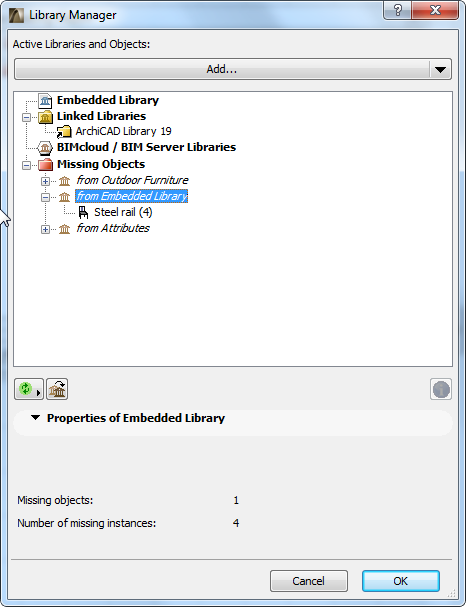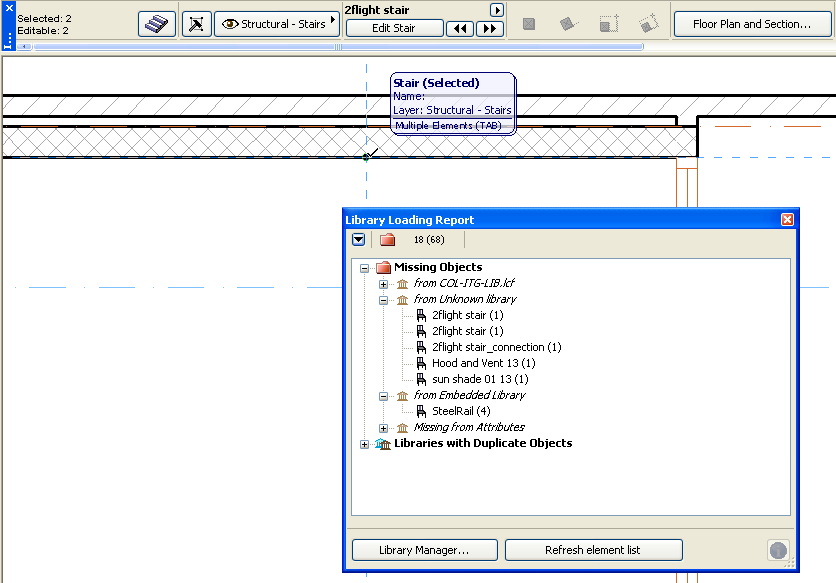
Troubleshooting Library Issues
From the following list, click on the specific library-related issue for more information:
Missing Objects and the Library Loading Report
Find and Select Missing Library Parts
Libraries with Duplicate Objects
Consolidate Multiple ARCHICAD Libraries
Delete Unused Linked Libraries
Migrating Libraries to ARCHICAD 19
Missing Objects and the Library Loading Report
Items in the Missing Objects folder of the Library Manager are missing from the project
•either because they were embedded objects, and have been deleted (you cannot retrieve them, since they no longer exist)
•or because they were located in libraries that have been deleted from the project or moved to a different location (to retrieve these objects, re-Add the unavailable libraries to Library Manager, then click refresh.
See Refresh Status of Placed Objects.

Missing objects are listed in the Library Manager together with:
•the name of the source library if any, with its last known location, from which the missing objects originate.
•number of missing object, plus the number of placed instances of each missing object. For each missing object, the number of its placed instances is shown in parentheses.
Objects listed under “Missing from unknown library” are missing objects about which no other information is available - their source library (or libraries) are not known.

The Library Loading Report appears if the project is missing any objects or if objects are duplicated in different libraries. In the Library Loading Report, the red folder at the top shows the total number of missing objects, followed by the total number of their placed instances in parentheses.

The Library Loading Report gives you an overview of problematic libraries (those containing duplicates) and problematic objects (those that are missing or which have several possible substitutes), with the number placed instances of each shown in parentheses.
In both the Library Manager and the Library Loading Report, click on any library about which you need more information, then click the Info button.

The appearing Information dialog summarizes all available data about the selected library: the total number of objects contained in the library; the list of placed or missing objects; the number of placed instances; lists of placed duplicates.
The missing items cannot be displayed on the plan. (The place of missing library parts is indicated by fuzzy dots.)
In a Teamwork project, you may encounter a category in the Library Manager or Library Loading Report entitled “Temporarily Missing.” This may occur when a user makes changes in a BIMcloud/BIM Server Library that result in placed objects being updated in some way. If those objects are reserved by any user, then all users joined in to the project will encounter the “Temporarily Missing” category.
This will be resolved as soon as the user(s) who have reserved the objects do a Send & Receive; then the objects will no longer be missing.
These files reference unsupported image formats.
For more information, see Image Files in the Embedded Library.
Find and Select Missing Library Parts
To find and select missing library parts in the active window, use the Find & Select function.
See also Find and Select Elements.
1.In the first “Criteria” row in the Find and Select dialog box, choose a GDL object type element.
2.In the next row, for the next criterion, choose “Library Part.”
3.As the value, select “Is Missing”.
Note: You can also choose “Is Not Missing” as the value; this will select all instances of the defined GDL Object types, except for the ones whose library object is missing.

4.Click the Plus button to execute the Find & Select function.

Note: You may wish to zoom to the selection: right-click in the window, then choose Zoom to Selection from the context menu.
If you have modified the name of a library folder, or changed its location in the file hierarchy, then the next time you open ARCHICAD, the library folder listed in the Library Manager dialog box will be shown as Unavailable. (An unavailable source library and its last known path is listed only if it was available to the project at an earlier time.)
Placed objects from unavailable libraries are listed in the “Missing Objects” folder; in the project model, they are represented by fuzzy green dots.

The solution is to click Link Library from the Add button’s pop-up list, and browse for the library file under its new name or location.
Libraries with Duplicate Objects
This section of Library Manager is visible if any two project libraries contain one or more of the same objects; these libraries are listed in pairs. For each such pair of libraries, the following information is listed:
•Number of duplicate objects
•Number of placed duplicate objects
•Number of placed duplicate instances
Select any library pair and click the Info icon for more information.

In the Information box, click the black arrow to choose the list format you need:
•List placed duplicates
•List all duplicates
•List all placeable duplicates
•List all non-placeable duplicates
The problem with having a lot of duplicate objects in your projects is twofold: every time you load your libraries, you will be loading many superfluous objects and/or libraries, causing unnecessary slowdowns; and the presence of duplicates can lead to further ambiguities if you should modify a duplicate library object or save it under a new name.
See Substituted Objects.
There are several possible strategies to resolve the issue of duplicates:
•If the Libraries with Duplicate Objects are ARCHICAD Libraries, it is best to Consolidate.
See Consolidate Multiple ARCHICAD Libraries.
•If all the placed objects from one of the libraries are duplicates (i.e. these objects also exist in the other library), you can remove the first library altogether.
•If the duplicated libraries are not ARCHICAD libraries, you might consider comparing the two libraries’ contents manually (open the library folder at its source and view the objects), and then delete the duplicates from one of the libraries.
•If the duplicate placed objects are project-specific, you should embed them into the project. This will also eliminate the library from the project.
See Embed Placed Objects from a Library.
An object in this category has been placed in the project, but several possible substitutes for this object (that is, objects with the same ID as the placed object, though they may be named differently) exist in at least two linked libraries. ARCHICAD randomly uses one or the other source for the object’s placed instances.
To avoid this situation, you should manually replace the instances of the “substituted object” with a single one of its possible duplicates from the loaded libraries.
(To do this, you can use Find & Select to locate the placed instances of the substituted object. Then choose a specific library object from the loaded libraries to replace it.)
Consolidate Multiple ARCHICAD Libraries
Any time you add an additional ARCHICAD library to a project that already has one, ARCHICAD will recognize the presence of older-version ARCHICAD libraries (versions 10 and later). In this case, the yellow Consolidate button appears in Library Manager.
Note: The Consolidate button appears in Library Manager any time that at least one outdated ARCHICAD Library - that is, a Library which is not the latest one - has been added to the project.
![]()

Consolidating ARCHICAD libraries is recommended because:
•it replaces the old ARCHICAD libraries with the latest library
•it loads the requisite Migration Libraries so that you still have access to any now-obsolete library parts that may still be placed in the project
•Migration Libraries are much smaller than the full ARCHICAD libraries, so you will save your project from a great many superfluous objects
•you avoid errors that can result from placing identically named library parts that are present in several loaded libraries
See also Migrating Libraries to ARCHICAD 19.
Delete Unused Linked Libraries
Library Manager tells you whether you have actually placed any objects from your linked libraries. If not, you don’t need that library and you can remove it from the project. In this example, there are no objects placed from the selected ARCHICAD library; you can remove it.

To remove a library folder, select it from Library Manager and click the blue X “Remove” icon.
The Windows operating system has a limit of 256 on the number of characters that the library path name can contain. Consequently, you may encounter a warning that the program is unable to save a local copy of the BIMcloud/BIM Server library, because the library path is too long.
To resolve this problem, try one of these solutions:
•Simplify the library’s file structure at its source. This solution requires that you have Server Administrator rights.
Go to the source file of the BIMcloud/BIM Server Library, and do one of the following:
-Create a container file (.lcf) out of the library folder, using File > Libraries and Objects > Create Container. Next, go to Manage Server Libraries (File > Libraries and Objects) and use the Relocate command to browse the location of server library’s new.lcf source file.
-Alternatively, create a different, simplified folder structure for the library (e.g. move the library folder to a higher position in the folder hierarchy so that the file path becomes shorter). Next, go to Manage Server Libraries (File > Libraries and Objects) and use the Refresh command to update the server library with its newly restructured source.
•Modify the destination of the local library copy.
Go to Options > Work Environment > Special Folders, and enter a different location for your Teamwork Local Data folder, which is the destination of your local copies of BIMcloud/BIM Server libraries. The new location should be at a higher level of the folder hierarchy, thus making the path shorter.